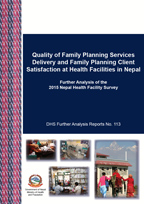
Abstract:
The quality of family planning (FP) services
at the health facility and client
satisfaction among those served on the day of
the survey in Nepal were examined using the
Nepal Health Facility Survey 2015 data. The
analysis was guided by the structure (staff,
guidelines, equipment, medicine, and
commodities), process (provider’s adherence
to the provision of quality FP service) and
outcome (client’s overall satisfaction with
services) framework suggested by Donabedian
(1988). The results showed that about 98% of
the health facilities in Nepal are providing
at least one FP method in most health
facilities for six or more days per week.
The service readiness status of the health
facility did not appear to be a significant
influencer in determining the quality of FP
services or FP client satisfaction. The
provider’s adherence to the provision of
quality FP services did not show differences
by most characteristics of clients,
providers, and facilities in this study.
Clients who were counseled on a FP method,
when compared with those not counseled, were
more likely to receive quality FP service.
Similarly, services received from a provider
with the opportunity of promotion were more
likely to receive quality FP services.
Clients who lived in the hills ecological
region were less likely to be satisfied than
those living in mountainous regions.
Although 88.5% of clients were satisfied with
the FP service they received in the health
facility, higher client satisfaction was
observed among those who received services
from a provider with their job description;
those receiving FP services at primary health
care centers (PHCCs), health posts (HPs), and
urban health centers (UHCs); and those
receiving services from a facility with
electricity. Clients living in the hills,
when compared with mountains, and those
living in Province 2 compared with Province
1, were less likely to be satisfied. This
indicates that improving the skills of
providers, ensuring job descriptions for all
providers, improving the FP service delivery
system in the facility, and having
electricity in the facility all lead to
improved client satisfaction. Because
improved service readiness did not appear as
an influencing factor in process as well as
outcome measures, there is a clear need to
improve the lacking or poor components of FP
service readiness at all facility levels.
 Quality of Family Planning Services Delivery and Family Planning Client Satisfaction at Health Facilities in Nepal (PDF, 1924K)
Quality of Family Planning Services Delivery and Family Planning Client Satisfaction at Health Facilities in Nepal (PDF, 1924K)
